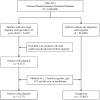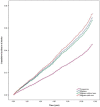Risk of peripheral artery disease and stroke in migraineurs with or without aura: a nationwide population-based cohort study
- PMID: 35919822
- PMCID: PMC9339415
- DOI: 10.7150/ijms.72119
Risk of peripheral artery disease and stroke in migraineurs with or without aura: a nationwide population-based cohort study
Abstract
Background: Migraine is deemed a neurovascular disorder and there is growing evidence on the increased risk of cardiovascular disease, especially ischemic stroke, in patients with migraine. However the risk of peripheral artery disease (PAD) and stroke in migraineurs and the association between migraineurs with or without aura is still under debate. Our study aimed to identify the risk of PAD and stroke in migraineurs with or without aura. Methods: This was a population-based cohort study utilizing Taiwan Longitudinal Health Insurance Database (LHID2010). Patients with coding of migraine from 2002 to 2011 were enrolled and those with established cardiovascular disease defined as myocardial infarction, stroke, PAD, venous thromboembolism, atrial fibrillation and heart failure diagnosis before the index date were excluded. Participants were categorized into migraine group, migraine without aura group, and migraine with aura group respectively. The subjects in the three groups were propensity score-matched randomly to their counterparts without migraine. The study outcome was PAD and stroke. The Cox proportional hazard model was used to estimate the hazard ratios with 95% confidence interval (CI) for the association between migraine and the incident events of disease, after controlling for related variables. Results: The migraine, migraine without aura, and migraine with aura group included 5,173 patients, 942 patients and 479 patients respectively after propensity score-matching. The migraine group had an increased risk of PAD [adjusted hazard ratio (aHR): 1.93; 95% confidence interval (CI): 1.45-2.57; p < 0.001] and stroke (aHR: 1.55; 95% CI: 1.35-1.77; p < 0.001) compared to their non-migraine controls. Both the groups of migraine without aura and with aura had an increased risk of stroke (aHR: 1.49, 95% CI: 1.11-2.00; p = 0.008; aHR: 1.63, 95% CI: 1.10-2.43; p = 0.016). With regards to the outcome of PAD, the group of migraine with aura had a trend of an increased risk but did not reach statistical significance (aHR: 1.95, 95% CI: 0.86-4.40; p = 0.108). Conclusion: Migraineurs without established cardiovascular disease had a significantly increased risk of PAD and stroke, and the risk of stroke persists in migraineurs with or without aura, with an increased trend of PAD in migraineurs with aura. Our study result should remind clinical physicians of the risk of PAD in the future among migraineurs even without established cardiovascular disease currently, and screening for PAD and stroke may be needed in caring patients with migraine.
© The author(s).
Conflict of interest statement
Competing Interests: The authors have declared that no competing interest exists.
Figures
Similar articles
-
Migraine and risk of cardiovascular diseases: Danish population based matched cohort study.BMJ. 2018 Jan 31;360:k96. doi: 10.1136/bmj.k96. BMJ. 2018. PMID: 29386181 Free PMC article.
-
Migraine, vascular risk, and cardiovascular events in women: prospective cohort study.BMJ. 2008 Aug 7;337:a636. doi: 10.1136/bmj.a636. BMJ. 2008. PMID: 18687721 Free PMC article.
-
Cardiovascular risk factors and migraine: the GEM population-based study.Neurology. 2005 Feb 22;64(4):614-20. doi: 10.1212/01.WNL.0000151857.43225.49. Neurology. 2005. PMID: 15728281
-
Migraine and the risk for stroke and cardiovascular disease.Curr Cardiol Rep. 2014 Sep;16(9):524. doi: 10.1007/s11886-014-0524-1. Curr Cardiol Rep. 2014. PMID: 25059466 Review.
-
Migraine and the risk of coronary heart disease and ischemic stroke in women.Womens Health (Lond). 2009 Jan;5(1):69-77. doi: 10.2217/17455057.5.1.69. Womens Health (Lond). 2009. PMID: 19102643 Review.
Cited by
-
Causality between migraine and cardiovascular disease: a bidirectional Mendelian randomization study.J Headache Pain. 2024 Aug 13;25(1):130. doi: 10.1186/s10194-024-01836-w. J Headache Pain. 2024. PMID: 39135164 Free PMC article.
-
Migraine with and without aura-two distinct entities? A narrative review.J Headache Pain. 2025 Apr 14;26(1):77. doi: 10.1186/s10194-025-01998-1. J Headache Pain. 2025. PMID: 40229683 Free PMC article. Review.
-
Mendelian randomization analysis reveals causal effects of migraine and its subtypes on early-onset ischemic stroke risk.Sci Rep. 2024 Dec 28;14(1):31505. doi: 10.1038/s41598-024-83344-0. Sci Rep. 2024. PMID: 39733194 Free PMC article.
-
Acupuncture Is Effective at Reducing the Risk of Stroke in Patients with Migraines: A Real-World, Large-Scale Cohort Study with 19-Years of Follow-Up.Int J Environ Res Public Health. 2023 Jan 17;20(3):1690. doi: 10.3390/ijerph20031690. Int J Environ Res Public Health. 2023. PMID: 36767053 Free PMC article. Clinical Trial.
References
-
- Wang SJ, Fuh JL, Young YH, Lu SR, Shia BC. Prevalence of migraine in Taipei, Taiwan: a population-based survey. Cephalalgia. 2000;20:566–72. - PubMed
-
- Sacco S, Ornello R, Ripa P, Tiseo C, Degan D, Pistoia F. et al. Migraine and risk of ischaemic heart disease: a systematic review and meta-analysis of observational studies. European journal of neurology. 2015;22:1001–11. - PubMed
MeSH terms
LinkOut - more resources
Full Text Sources
Medical
Miscellaneous




